
Tigger is a fictional character, an anthropomorphic stuffed tiger. He was originally introduced in the 1928 story collection The House at Pooh Corner, the sequel to the 1926 book Winnie-the-Pooh by A. A. Milne. Like other Pooh characters, Tigger is based on one of Christopher Robin Milne's stuffed toy animals. He appears in the Disney animated versions of Winnie the Pooh and has also appeared in his own film, The Tigger Movie (2000).

Christopher Robin is a character created by A. A. Milne, based on his son Christopher Robin Milne. The character appears in the author's popular books of poetry and Winnie-the-Pooh stories, and has subsequently appeared in various Disney adaptations of the Pooh stories.

Eeyore is a fictional character in the Winnie-the-Pooh books by A. A. Milne. He is generally characterized as a pessimistic, gloomy, depressed, anhedonic, old grey stuffed donkey who is a friend of the title character, Winnie-the-Pooh.
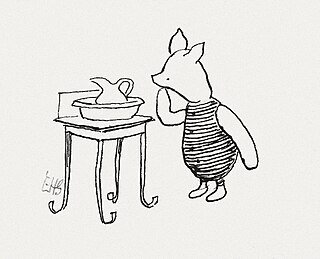
Piglet is a fictional character from A. A. Milne's Winnie-the-Pooh books. Piglet is Winnie‑the‑Pooh's closest friend amongst all the toys and animals featured in the stories. Although he is a "Very Small Animal" of a generally timid disposition, he tries to be brave and on occasion conquers his fears.

Rabbit is a fictional character in the book series and cartoons Winnie-the-Pooh. He is a friend of Winnie-the-Pooh, regards himself as practical and tends to take the lead, though not always with the results that he intends.

Roo is a fictional character created in 1926 by A. A. Milne and first featured in the book Winnie-the-Pooh. He is a young kangaroo and his mother is Kanga. Like most other Pooh characters, Roo is based on a stuffed toy animal that belonged to Milne's son, Christopher Robin Milne. Though stuffed, Roo was lost in the 1930s in an apple orchard somewhere in Sussex.

Piglet's Big Movie is a 2003 American animated musical adventure comedy-drama film released by Walt Disney Pictures on March 21, 2003. The film features the characters from the Winnie-the-Pooh books written by A. A. Milne and E. H. Shepard and is the third theatrically released Winnie the Pooh feature. In this film, Piglet is ashamed of being small and clumsy and wanders off into the Hundred Acre Wood, leading all of his friends to form a search party to find him.

Winnie-the-Pooh is a 1926 children's book by English author A. A. Milne and English illustrator E. H. Shepard. The book is set in the fictional Hundred Acre Wood, with a collection of short stories following the adventures of an anthropomorphic teddy bear, Winnie-the-Pooh, and his friends Christopher Robin, Piglet, Eeyore, Owl, Rabbit, Kanga, and Roo. It is the first of two story collections by Milne about Winnie-the-Pooh, the second being The House at Pooh Corner (1928). Milne and Shepard collaborated previously for English humour magazine Punch, and in 1924 created When We Were Very Young, a poetry collection. Among the characters in the poetry book was a teddy bear Shepard modelled after his son's toy. Following this, Shepard encouraged Milne to write about his son Christopher Robin Milne's toys, and so they became the inspiration for the characters in Winnie-the-Pooh.
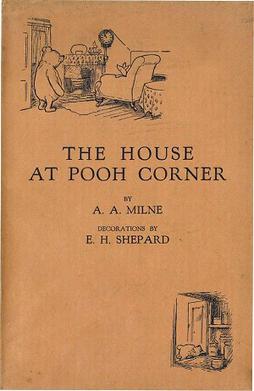
The House at Pooh Corner is a 1928 children's book by A. A. Milne and illustrated by E. H. Shepard. This book is the second novel, and final one by Milne, to feature Winnie-the-Pooh and his world. The book is also notable for introducing the character, Tigger. The book's exact date of publication is unknown beyond the year 1928, but it was likely towards the end of the year as book reviews for the book began appearing during October 1928.
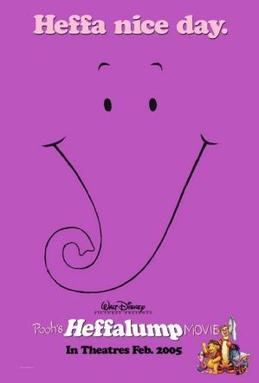
Pooh's Heffalump Movie is a 2005 American animated musical adventure comedy-drama film produced by the Japanese office of Disneytoon Studios and released by Walt Disney Pictures. Featuring characters from A. A. Milne's Winnie-the-Pooh stories, the film is the fourth theatrical animated film in Disney's Winnie the Pooh franchise and DisneyToon Studios's third adaptation of Winnie the Pooh stories, following The Tigger Movie (2000) and Piglet's Big Movie (2003). The film was released theatrically on February 11, 2005. The film was followed by a direct-to-video Halloween sequel titled Pooh's Heffalump Halloween Movie which came out seven months after the film's release.

Winnie the Pooh and the Blustery Day is a 1968 American animated featurette based on the third, fifth, ninth, and tenth chapters of Winnie-the-Pooh and the second, eighth, and ninth chapters from The House at Pooh Corner by A. A. Milne. The featurette was directed by Wolfgang Reitherman, produced by Walt Disney Productions and released by Buena Vista Distribution Company on December 20, 1968, as a double feature with the live-action comedy feature The Horse in the Gray Flannel Suit. This was the second of the studio's Winnie the Pooh theatrical featurettes. It was later added as a segment to the 1977 film The Many Adventures of Winnie the Pooh. The music was written by Richard M. Sherman and Robert B. Sherman. It was notable for being the last Disney animated short to be produced by Walt Disney, who died of lung cancer on December 15, 1966, two years before its release.

Winnie the Pooh and a Day for Eeyore is a 1983 American animated featurette based on the sixth chapter of both books Winnie-the-Pooh and The House at Pooh Corner by A.A. Milne. Produced by Walt Disney Productions and distributed by Buena Vista Distribution, the short initially received limited release on March 11, 1983, before expanding to a wide release on March 25 as part of a double feature with the re-issue of The Sword in the Stone (1963), which it accompanied in most countries except Australia where it accompanied a reissue of Bedknobs and Broomsticks (1971). Directed by Rick Reinert, the featurette featured the voices of Hal Smith, John Fiedler, Will Ryan, Ralph Wright, and Paul Winchell.
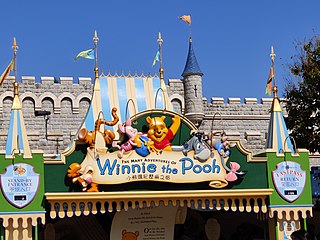
The Many Adventures of Winnie the Pooh is a dark ride based upon the 1977 film of the same name, itself based on the Winnie-the-Pooh books by A. A. Milne. The attraction exists in slightly different forms at the Magic Kingdom in the Walt Disney World Resort, Disneyland, Hong Kong Disneyland, and Shanghai Disneyland Park. Pooh's Hunny Hunt, located in Tokyo Disneyland, is an enhanced "E-ticket class" attraction, featuring full audio animatronics and a trackless ride system.

A Very Merry Pooh Year is a 2002 American direct-to-video Christmas animated musical film produced by Walt Disney Animation (France), S.A. The film features the 1991 Christmas television special Winnie the Pooh and Christmas Too, as well as a new film, Happy Pooh Year. The film animation production was done by Wang Film Productions Co., Ltd., and Sunwoo Animation, (Korea) Co., Ltd.
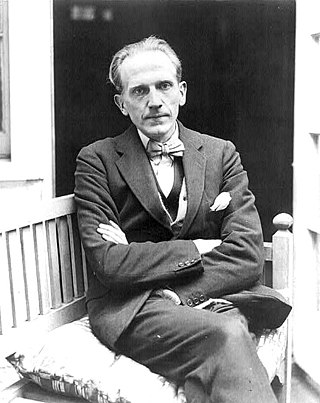
Disney's Pooh & Friends is a book series based on the Pooh stories by A. A. Milne, along with the Lessons from the Hundred Acre Wood series.

Winnie-the-Pooh is a fictional anthropomorphic teddy bear created by English author A. A. Milne and English illustrator E. H. Shepard. Winnie-the-Pooh first appeared by name in a children's story commissioned by London's Evening News for Christmas Eve 1925. The character is based on a stuffed toy that Milne had bought for his son Christopher Robin in Harrods department store.

Winnie the Pooh: A Valentine for You is a Valentine's Day special based on A. A. Milne's stories, originally broadcast on ABC on February 13, 1999. This is the final role of Paul Winchell as Tigger before his retirement from the role a few days after its release. He did, however, voice Tigger for the Many Adventures of Winnie the Pooh attraction at Walt Disney World Resort. A Valentine for You was released on VHS in 2000 and 2001 and on DVD in 2004 and 2010. It was made available for streaming on Disney+ on February 11, 2022.
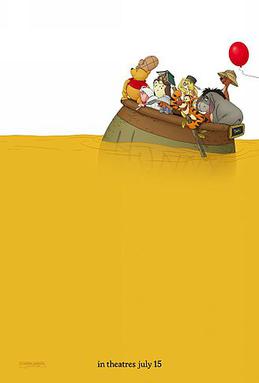
Winnie the Pooh is a 2011 American animated musical comedy film produced by Walt Disney Animation Studios and released by Walt Disney Pictures. It is based on the book series of the same name written by A. A. Milne and illustrated by E. H. Shepard. The film is a revival of Disney's Winnie the Pooh franchise, the fifth theatrical Winnie the Pooh film released, and the second in the Disney Animated Canon. It was directed by Stephen Anderson and Don Hall, and produced by Peter Del Vecho and Clark Spencer, based on a story that Anderson and Hall conceived with Clio Chiang, Don Dougherty, Kendelle Hoyer, Brian Kesinger, Nicole Mitchell, and Jeremy Spears.
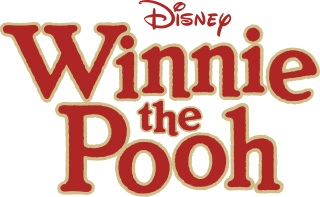
Winnie the Pooh is a media franchise produced by The Walt Disney Company, based on A. A. Milne and E. H. Shepard's stories featuring Winnie-the-Pooh. It started in 1966 with the theatrical release of the short Winnie the Pooh and the Honey Tree.



















